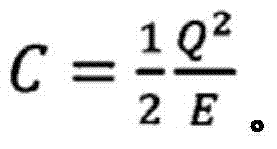A polar1zable ion-conducting material
A technology of conductive materials and polarized ions, applied in circuits, capacitors, fuel cells, etc., can solve problems such as difficult amplification and expensive double-layer capacitors
- Summary
- Abstract
- Description
- Claims
- Application Information
AI Technical Summary
Problems solved by technology
Method used
Image
Examples
Embodiment 1
[0023] Fabrication of Poly(4-Lithium Styrene Sulfonate) Membranes
[0024] Polarizable ion-conducting membranes were fabricated following the procedures described in Xie et al., Energy & Environmental Science, 4, 3960-65 (2011); and Xie et al., Advanced Materials, 24, 76-81 (2012).
[0025] A solution of poly(4-lithium styrenesulfonate) in water (300 g / L) was cast onto the substrate to form a film with a thickness of 0.1 mm. After drying it in air, the film was peeled off from the substrate. Cut the flexible and foldable membrane into small pieces.
[0026] Assembly and testing of graphite / membrane / graphite devices
[0027] Devices were assembled from the 1.0 cm x 1.0 cm x 0.1 mm film by sandwiching the film between two sheets of graphite electrodes. The device was placed in a device holder consisting of a hollow cube (made of insulating plastic) and two aluminum plates. By being fastened up to 700kg / cm 2 The pressure screws are used to mount the device between two alu...
Embodiment 2
[0043] Fabrication of poly(4-sodium styrenesulfonate) membrane
[0044] Following the procedure described in Example 1, a poly(4-sodium styrenesulfonate) membrane with a thickness of 0.1 mm was produced.
[0045] Assembly and testing of graphite / membrane / graphite devices
[0046] Following the procedure described in Example 1, devices were assembled and subjected to charge-discharge tests at a constant voltage of 6V and a constant resistance of 1.2kΩ, 5.3kΩ, or 8.0kΩ. The average open circuit voltage of the poly(4-sodium styrenesulfonate) film was found to be 2.7V.
Embodiment 3
[0048] Fabrication of poly(4-styrenesulfonic acid) membranes
[0049] Following the procedure described in Example 1, a poly(4-styrenesulfonic acid) film with a thickness of 0.1 mm was produced.
[0050] Assembly and testing of graphite / membrane / graphite devices
[0051] Following the procedure described in Example 1, devices were assembled and subjected to charge-discharge tests at a constant voltage of 6V and a constant resistance of 1.2kΩ, 5.3kΩ, or 8.0kΩ. The average open circuit voltage of the poly(4-styrenesulfonic acid) membrane was found to be 1.3V.
PUM
| Property | Measurement | Unit |
|---|---|---|
| capacitance | aaaaa | aaaaa |
| thickness | aaaaa | aaaaa |
| thickness | aaaaa | aaaaa |
Abstract
Description
Claims
Application Information
 Login to View More
Login to View More - R&D
- Intellectual Property
- Life Sciences
- Materials
- Tech Scout
- Unparalleled Data Quality
- Higher Quality Content
- 60% Fewer Hallucinations
Browse by: Latest US Patents, China's latest patents, Technical Efficacy Thesaurus, Application Domain, Technology Topic, Popular Technical Reports.
© 2025 PatSnap. All rights reserved.Legal|Privacy policy|Modern Slavery Act Transparency Statement|Sitemap|About US| Contact US: help@patsnap.com

